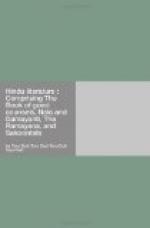to the scene of her earliest memories, the circling
wilderness of foliage, the shining tank with the round
leaves of the lilies, the murmuring dusk under the
vast branches of the central casuarina-tree.
Here, in a mystical retirement more irksome to a European
in fancy than to an Oriental in reality, the brain
of this wonderful child was moulded. She was
pure Hindoo, full of the typical qualities of her
race and blood, and, as the present volume shows us
for the first time, preserving to the last her appreciation
of the poetic side of her ancient religion, though
faith itself in Vishnu and Siva had been cast aside
with childish things and been replaced by a purer faith.
Her mother fed her imagination with the old songs and
legends of their people, stories which it was the
last labor of her life to weave into English verse;
but it would seem that the marvellous faculties of
Toru’s mind still slumbered, when, in her thirteenth
year, her father decided to take his daughters to
Europe to learn English and French. To the end
of her days Toru was a better French than English scholar.
She loved France best, she knew its literature best,
she wrote its language with more perfect elegance.
The Dutts arrived in Europe at the close of 1869,
and the girls went to school, for the first and last
time, at a French pension. They did not remain
there very many months; their father took them to
Italy and England with him, and finally they attended
for a short time, but with great zeal and application,
the lectures for women at Cambridge. In November,
1873, they went back to Bengal, and the four remaining
years of Toru’s life were spent in the old garden-house
at Calcutta, in a feverish dream of intellectual effort
and imaginative production. When we consider
what she achieved in these forty-five months of seclusion,
it is impossible to wonder that the frail and hectic
body succumbed under so excessive a strain.
She brought with her from Europe a store of knowledge
that would have sufficed to make an English or French
girl seem learned, but which in her case was simply
miraculous. Immediately on her return she began
to study Sanscrit with the same intense application
which she gave to all her work, and mastering the
language with extraordinary swiftness, she plunged
into its mysterious literature. But she was born
to write, and despairing of an audience in her own
language, she began to adopt ours as a medium for
her thought. Her first essay, published when she
was eighteen, was a monograph, in the “Bengal
Magazine,” on Leconte de Lisle, a writer with
whom she had a sympathy which is very easy to comprehend.
The austere poet of “La Mort de Valmiki”
was, obviously, a figure to whom the poet of “Sindhu”
must needs be attracted on approaching European literature.
This study, which was illustrated by translations
into English verse, was followed by another on Josephin
Soulary, in whom she saw more than her maturer judgment
might have justified. There is something very




